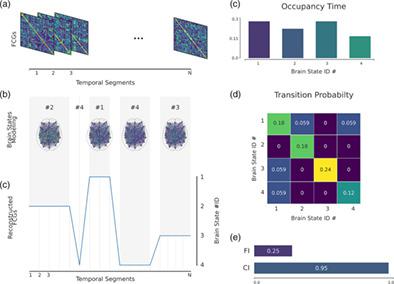当前位置:
X-MOL 学术
›
Hum. Brain Mapp.
›
论文详情
Our official English website, www.x-mol.net, welcomes your
feedback! (Note: you will need to create a separate account there.)
Dyconnmap: Dynamic connectome mapping—A neuroimaging python module
Human Brain Mapping ( IF 3.5 ) Pub Date : 2021-07-11 , DOI: 10.1002/hbm.25589 Avraam D Marimpis 1, 2, 3 , Stavros I Dimitriadis 2, 4, 5, 6, 7, 8 , Rainer Goebel 1, 3
Human Brain Mapping ( IF 3.5 ) Pub Date : 2021-07-11 , DOI: 10.1002/hbm.25589 Avraam D Marimpis 1, 2, 3 , Stavros I Dimitriadis 2, 4, 5, 6, 7, 8 , Rainer Goebel 1, 3
Affiliation

|
Despite recent progress in the analysis of neuroimaging data sets, our comprehension of the main mechanisms and principles which govern human brain cognition and function remains incomplete. Network neuroscience makes substantial efforts to manipulate these challenges and provide real answers. For the last decade, researchers have been modelling brain structure and function via a graph or network that comprises brain regions that are either anatomically connected via tracts or functionally via a more extensive repertoire of functional associations. Network neuroscience is a relatively new multidisciplinary scientific avenue of the study of complex systems by pursuing novel ways to analyze, map, store and model the essential elements and their interactions in complex neurobiological systems, particularly the human brain, the most complex system in nature. Due to a rapid expansion of neuroimaging data sets' size and complexity, it is essential to propose and adopt new empirical tools to track dynamic patterns between neurons and brain areas and create comprehensive maps. In recent years, there is a rapid growth of scientific interest in moving functional neuroimaging analysis beyond simplified group or time-averaged approaches and sophisticated algorithms that can capture the time-varying properties of functional connectivity. We describe algorithms and network metrics that can capture the dynamic evolution of functional connectivity under this perspective. We adopt the word ‘chronnectome’ (integration of the Greek word ‘Chronos’, which means time, and connectome) to describe this specific branch of network neuroscience that explores how mutually informed brain activity correlates across time and brain space in a functional way. We also describe how good temporal mining of temporally evolved dynamic functional networks could give rise to the detection of specific brain states over which our brain evolved. This characteristic supports our complex human mind. The temporal evolution of these brain states and well-known network metrics could give rise to new analytic trends. Functional brain networks could also increase the multi-faced nature of the dynamic networks revealing complementary information. Finally, we describe a python module (https://github.com/makism/dyconnmap) which accompanies this article and contains a collection of dynamic complex network analytics and measures and demonstrates its great promise for the study of a healthy subject's repeated fMRI scans.
中文翻译:

Dyconnmap:动态连接组映射——一个神经成像 python 模块
尽管最近在分析神经影像数据集方面取得了进展,但我们对支配人类大脑认知和功能的主要机制和原理的理解仍然不完整。网络神经科学为应对这些挑战做出了巨大努力并提供了真正的答案。在过去的十年中,研究人员一直在通过图表或网络对大脑结构和功能进行建模,这些大脑区域要么在解剖学上通过束连接,要么通过更广泛的功能关联在功能上连接。网络神经科学是研究复杂系统的一个相对较新的多学科科学途径,它通过寻求新的方法来分析、映射、存储和建模复杂神经生物学系统(尤其是人脑)中的基本元素及其相互作用,自然界中最复杂的系统。由于神经影像数据集的规模和复杂性迅速扩大,因此必须提出并采用新的经验工具来跟踪神经元和大脑区域之间的动态模式并创建全面的地图。近年来,科学对功能神经影像分析的兴趣迅速增长,使其超越了简化组或时间平均方法以及可以捕获功能连接的时变特性的复杂算法。我们描述了可以在这个角度下捕捉功能连接的动态演变的算法和网络指标。我们采用“chronnectome”这个词(希腊词“Chronos”的整合,意思是时间,和连接组)来描述网络神经科学的这一特定分支,该分支探索相互了解的大脑活动如何以功能方式在时间和大脑空间中相互关联。我们还描述了对时间进化的动态功能网络的良好时间挖掘如何能够检测到我们大脑进化的特定大脑状态。这一特征支持我们复杂的人类思维。这些大脑状态和众所周知的网络指标的时间演变可能会产生新的分析趋势。功能性大脑网络还可以增加动态网络的多面性,揭示互补信息。最后,我们描述了一个python模块(https://github.com)。
更新日期:2021-09-19
中文翻译:

Dyconnmap:动态连接组映射——一个神经成像 python 模块
尽管最近在分析神经影像数据集方面取得了进展,但我们对支配人类大脑认知和功能的主要机制和原理的理解仍然不完整。网络神经科学为应对这些挑战做出了巨大努力并提供了真正的答案。在过去的十年中,研究人员一直在通过图表或网络对大脑结构和功能进行建模,这些大脑区域要么在解剖学上通过束连接,要么通过更广泛的功能关联在功能上连接。网络神经科学是研究复杂系统的一个相对较新的多学科科学途径,它通过寻求新的方法来分析、映射、存储和建模复杂神经生物学系统(尤其是人脑)中的基本元素及其相互作用,自然界中最复杂的系统。由于神经影像数据集的规模和复杂性迅速扩大,因此必须提出并采用新的经验工具来跟踪神经元和大脑区域之间的动态模式并创建全面的地图。近年来,科学对功能神经影像分析的兴趣迅速增长,使其超越了简化组或时间平均方法以及可以捕获功能连接的时变特性的复杂算法。我们描述了可以在这个角度下捕捉功能连接的动态演变的算法和网络指标。我们采用“chronnectome”这个词(希腊词“Chronos”的整合,意思是时间,和连接组)来描述网络神经科学的这一特定分支,该分支探索相互了解的大脑活动如何以功能方式在时间和大脑空间中相互关联。我们还描述了对时间进化的动态功能网络的良好时间挖掘如何能够检测到我们大脑进化的特定大脑状态。这一特征支持我们复杂的人类思维。这些大脑状态和众所周知的网络指标的时间演变可能会产生新的分析趋势。功能性大脑网络还可以增加动态网络的多面性,揭示互补信息。最后,我们描述了一个python模块(https://github.com)。











































 京公网安备 11010802027423号
京公网安备 11010802027423号